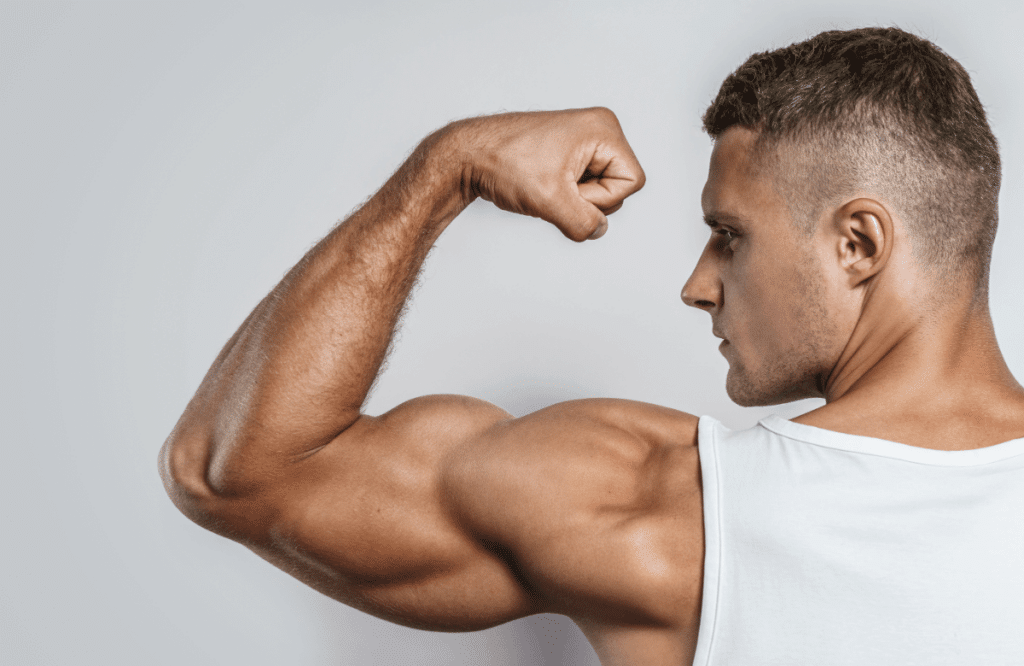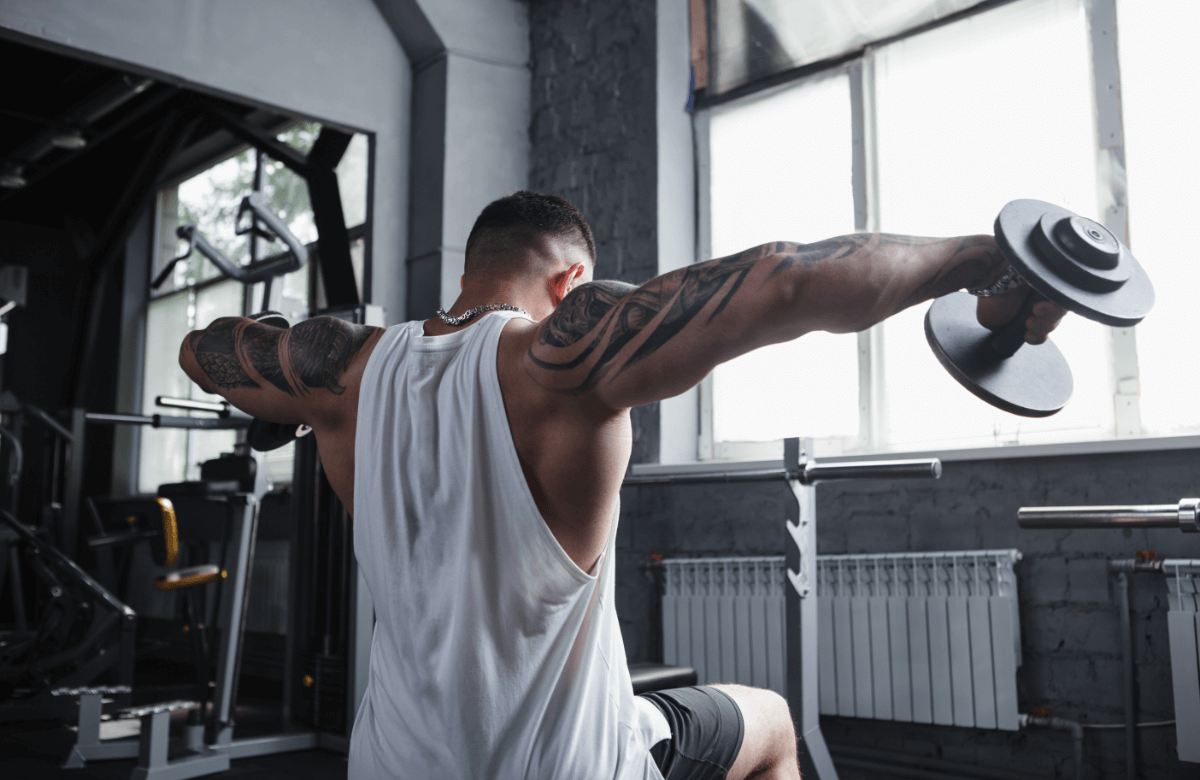There are serious benefits to having strong shoulder muscles. Shoulder strength is what helps you maintain balance as you run at an incline and stabilizes your spine as you lift heavy weights. Having strong shoulders is a precursor for building strength in other muscle groups as it takes great shoulder strength to perform many movements and exercises.
Effective shoulder-strengthening exercises can benefit your overall performance in sports and strength workouts. The lateral raise is one such exercise that can maximize your shoulder workouts. Let’s take a look at how you can develop massive shoulders with the help of this move.
Jump to:
Intro to Lateral Raises
The lateral raise is an excellent shoulder exercise that requires you to lift dumbbells away from your body in a motion that’s not unlike a bird flapping its wings. This strength-training isolation exercise is most effective when completed with light weights and higher reps to ensure proper form that results in stronger shoulder muscles.
Which Muscles Do Lateral Raises Work?
Lateral raises primarily target the lateral deltoid muscles, which are triangular muscles located on the top and sides of the shoulder. The muscle rotation in the exercise also slightly works the front deltoids, located between the shoulder blades and collarbone, and the upper trapezius, a muscle that starts at the base of the neck and extends over the top of the shoulders. The rotation also slightly affects the posterior deltoid, though it’s a secondary muscle used.
As lateral raises strengthen the muscles surrounding your shoulder joint, you’ll gain a greater range of motion and stability in your shoulder. It can help prevent clicking and injury later on, especially for those who exercise regularly.
How to Do Lateral Raises with Proper Form
To begin a lateral raise, start in a standing position with your feet around shoulder’s width apart. Hold a dumbbell in each hand near your thighs with elbows slightly bent. Activate your core and squeeze your glutes. Lift the dumbbells to your sides until your arms are horizontal at shoulder height. Pause at the top of the movement. With control, slowly lower your arms back down to complete the rep.
As with any shoulder exercise, it’s important to avoid the risk of injury by ensuring that your form is correct. Your training background will determine your weight selection as well as the amount of reps you should aim for. To avoid injury, check your body position and watch the following things:
Elbows
Many people make the mistake of pointing their elbows down while performing a lateral raise. This engages the biceps and the front deltoids. In order to make this a well-rounded shoulder workout, you’ll need to point your elbows up. By leading with your elbows as you extend your arms, more of an emphasis is placed on the side deltoids.
You also want to keep a soft elbow. Keeping your arms completely straight puts a lot of strain on your tendons and joints, where a slight bend in the elbow is the optimized range of motion for lateral raises. It helps you focus the movement on the lateral head and avoid overcompensation injuries.
Core Engagement
Engaging your core while exercising is important as it protects your spine and decreases your risk of injury. To engage your core, pull your belly button toward your spine. Flex the abdominals so that they are tight enough for someone to punch you in the stomach. Keep breathing normally as you proceed to do the lateral raise with a tight core.
Posture
Good posture is crucial while performing a lateral raise as it minimizes the risk of shoulder injury to the rotator cuff and ensures that you maximize your benefits of exercising the middle deltoid.
When executing a lateral raise, have good posture by standing up tall. You should have an even distribution of weight on both feet and your hips should be slightly bent forward. Keep your shoulders slightly ahead of your hips. Keep your chin tucked in as you perform the movement.
Squeezing Shoulder Blades
Squeezing your shoulder blades at the top of your lateral raise can put more of a focus on your lateral deltoid by isolating it. It also removes tension from your shoulders and eases the difficulty of the lift.
Common Mistakes in the Dumbbell Lateral Raises
To really nail the lateral raise, the attention is in the details. Many beginners make the mistake of choosing a weight that’s too heavy. Keep in mind that you should go with a lighter weight at a higher rep range while doing lateral raises to ensure you’re practicing safe movements. Weights that are too heavy can also cause you to take the focus off the shoulders by using too much of your torso as momentum to heave the weight up.
Another mistake people make when doing lateral raises is to shrug their shoulders as they bring their arms up. This cheats your lateral deltoids from doing that brunt of the lifting and also may be a good indicator that you’ve made an improper weight selection.
It’s important to keep a soft bend in the elbow and raise your hands 20 degrees in front of your chest—not in a straight line directly at your side. Keeping your arms too straight and to your side as you lift can cause a muscle strain injury.
Many people also make the mistake of raising the weights above shoulder height, but this takes the focus off of your shoulders.
Benefits of Doing Lateral Raises

Not only does adding lateral raises to your shoulder exercise regime help your shoulders look defined and toned, but it’s also beneficial for developing shoulder strength. Lateral raises help increase shoulder flexibility, mobility, range of motion, and stability.
Boost Shoulder Strength and Mass
The middle and lower traps are easy to miss in a typical arm workout, but lateral raises are great for toning these often-neglected muscles. The lateral raise forces the medial deltoid to engage as you raise your arms. Strengthening the deltoid shoulder muscles assists in overhead movements, pulling, and pressing. It’s safe to say that having strong shoulders makes for a better, more well-rounded athlete.
Advance the Move with Lateral Raise Variations
Another benefit of lateral raises is that you can shake things up and add variety with movement. Depending on your strength range, you can modify a lateral raise to make it more challenging or do it without dumbbells to perfect your form before adding weights.
Modifications and Variations
There are several lateral raise variations and modifications you can try if you want to include more comprehensive shoulder exercises in your workout routine.
Cable Lateral Raise
The cable lateral raise uses a pulley machine with a handle attached to the lowest cable to work one shoulder at a time.
To execute a cable lateral raise, stand to the side of the machine and grab the cable handle with one hand. Keep a soft bend in the elbow, and raise your arm to the side until it reaches shoulder height. Squeeze your shoulder muscles at the top of the movement and lower the handle with slow control.
Seated Lateral Raise
Executing a lateral raise while sitting as opposed to standing proves to be more of a challenge. Seated lateral raises prevent you from using your legs to help boost the weight up and help you maintain stable shoulders without having to concentrate on balance.
To do a seated lateral raise, sit at the edge of a bench while leaning slightly forward. Hold the dumbbells to your chest and directly under your shoulders with your palms facing each other. Slightly bend your arms and exhale as you lean back until you’re in an upright position while simultaneously extending your arms out and slightly behind you. Pause for a moment at the top, and with control, lower the dumbbells back down to your sides.
Wall Press Lateral Raise
In this lateral raise variation, you create more tension in the shoulders by pressing one arm into a wall while performing a lateral raise with your other arm.
To do a wall press lateral raise, stand to the side of the wall. Keep one arm at your side and press your hand that’s closest to the wall against it, on the knuckle side. Raise your other arm leading with your elbow up until you reach shoulder height.
Landmine Lateral Raise
A landmine attachment turns your barbell into a pivoting lever. This can add great variety to a typical lateral raise. When done with the proper form, the barbell helps guide your hand into the ideal position for activating your lateral deltoids.
To do a landmine lateral raise, kneel facing the landmine with the bar on one side. Hold the bar sleeve with your palm facing in. Keep your arm straight and raise the bar to shoulder level. Lower it back down with slow control.
Y Raise
Before doing a Y raise, you’ll want to begin by hinging a bit at the hip and raising both arms in front of you. At this point, do an external rotation to find your natural Y position. This will help you with the movement pattern as you do a Y raise.
To do a Y raise, you’ll grab a pair of dumbbells and with a slightly hinged hip, raise the dumbbells to the Y position. Pause at the top and slowly bring the dumbbells back to starting.
Bent Arm Lateral Raise
This bent arm lateral raise modification brings the weight closer to your body by shortening the lever and making it easier to lift the dumbbell closer to your body. You can even try this exercise with no weights.
To do this move, hinge at the hips and bend your elbows at a 90-degree angle. Hold the dumbbell with your palms facing your thighs. Raise the dumbbell until your hand is in line with your shoulder. Pause at the top before slowly lowering back down to the starting position.
FAQs About Doing Lateral Raises the Right Way
Here are some things you should know before adding lateral raises to your workout routine.
Should You Use Heavy Weights with Lateral Raises?
Using a weight that is too heavy while doing lateral raises can make the move less effective. Heavy weights may cause you to use too much momentum, which diminishes the role of the deltoid muscles. Start light and work your way up over time.
Are 3 Sets of Lateral Raises Enough?
In order to build muscle, you’ll want to do between 3-4 sets of 12-16 lateral raises each. Sticking with lighter weights can help you maintain stamina and raise your way to stronger and broader shoulder muscles.
Is 30lbs a Good Starting Weight for Lateral Raises?
Choosing the appropriate starting weight for a lateral raise depends greatly on your fitness level and background. Thirty pounds is quite heavy for beginners, so consider putting those 15lb weights down to grab a lighter pair of dumbbells that range between 2-10 lbs each.
Should You Do Lateral Raises Slow or Fast?
Lateral raises should be performed with slow control. Doing the movement slowly provides time over tension which can stimulate additional muscle growth in your deltoids. It may be tempting to rush through this challenging isolation exercise to get it over with, but you’d be cheating yourself out of some serious benefits.
Are Lateral Raises Worth It for Shoulder Strength?
Lateral raises prove to be advantageous for developing shoulder strength. Other factors like training volume and diet will determine how quickly you see results from incorporating lateral raises into your upper body strength-training routine.















